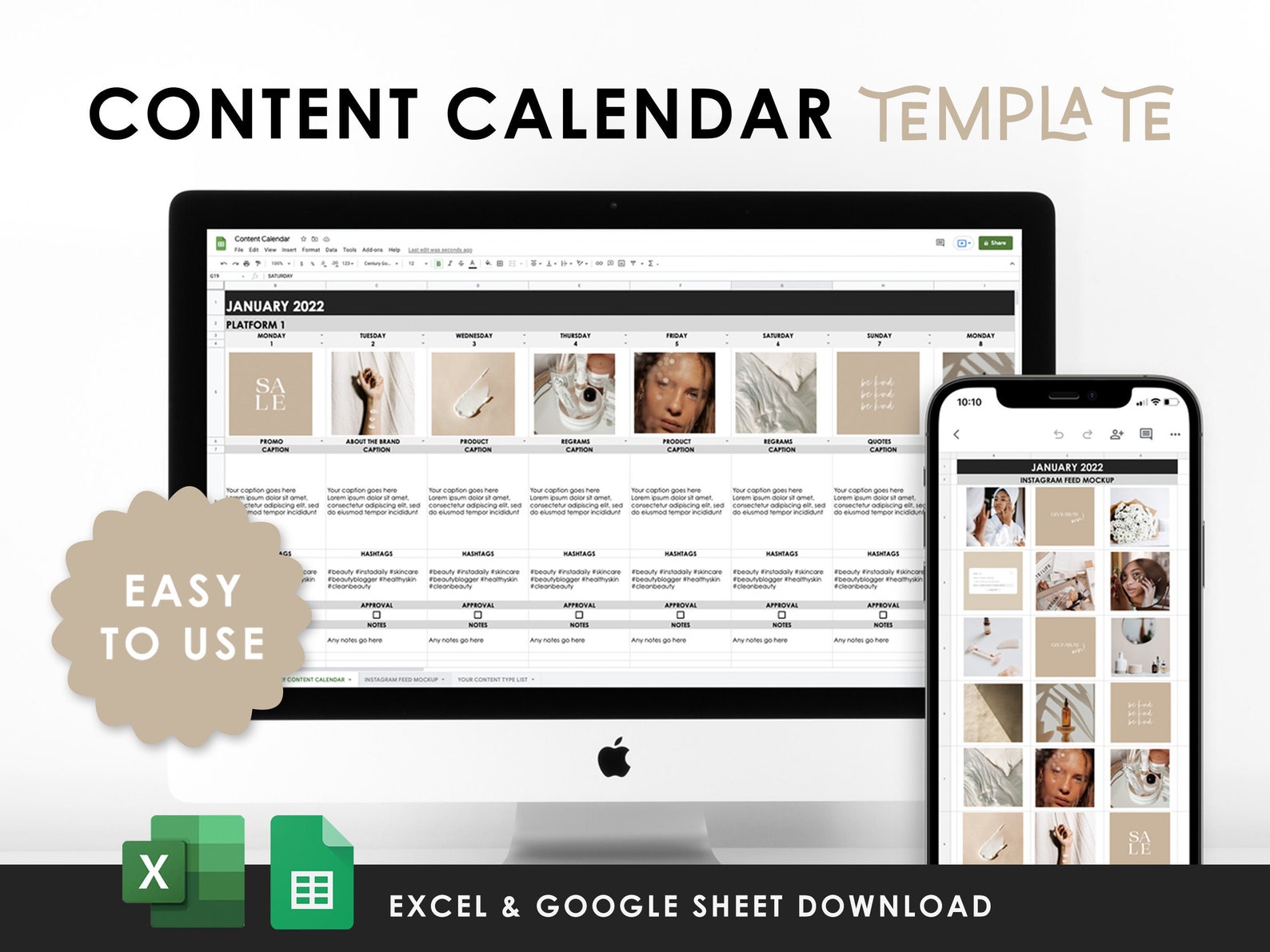How to Create a 12 Month Social Media Editorial Calendar: A Step-by-Step Guide
Creating a 12 month social media editorial calendar can help you stay organized and maximize your social media presence. It allows you to plan ahead and schedule your content in advance, ensuring that your social media channels remain active and engaging throughout the year. In this post, we will provide a step-by-step guide for creating a comprehensive 12 month editorial calendar for your social media strategy. By following these steps, you can streamline your social media planning and ensure that your content stays on brand and resonates with your audience.
In today’s crowded and competitive social media landscape, it’s more important than ever for businesses to be creative and dynamic in order to set themselves apart. A 12 month social media editorial calendar can help you plan and schedule content that is engaging, on-brand, and resonates with your audience. By being strategic and consistent with your content, you can build a strong and dedicated following on social media.
In this post, we will provide a step-by-step guide for creating a comprehensive 12 month editorial calendar that will help your business stand out and thrive on social media.
Creating a 12 month social media editorial calendar is a great way to plan out your content and ensure that you are consistently providing valuable and engaging content to your followers. Not only does it help you stay organized, but it can also help you save time and increase the effectiveness of your social media marketing efforts.
Here is a step-by-step guide on how to create a 12 month social media editorial calendar:
- Identify your goals and objectives
Before you start creating your calendar, it’s important to have a clear understanding of what you want to accomplish with your social media marketing. Do you want to increase brand awareness? Generate leads? Boost sales? Identifying your goals and objectives will help you create a calendar that is aligned with your overall marketing strategy.
- Determine your target audience
Knowing who you are trying to reach with your social media content is essential for creating an effective calendar. Consider the demographics, interests, and behaviors of your target audience, and use this information to create content that will resonate with them.
- Choose the right platforms
Not all social media platforms are created equal, and it’s important to choose the ones that are most relevant to your business and target audience. For example, if you are a B2B company, LinkedIn may be a better choice than Instagram. Consider the features and audience of each platform, and choose the ones that will give you the best results.
- Plan out your content
Once you have a clear understanding of your goals, target audience, and chosen platforms, it’s time to start planning out your content. Begin by brainstorming ideas for posts, and organize them into categories such as product updates, industry news, company events, and promotions. Then, create a rough schedule for when you will post each type of content.
Look for done for you content calendars to make this easy for you. Check out etsy or creative market for pre-made spreadsheets that you can easily pop information in.
- Fill in the details
Next, start filling in the details of your calendar. This includes deciding on specific topics, titles, and hashtags for each post, as well as determining the time and frequency of your posts. Keep in mind that the best times to post on social media can vary depending on the platform and your target audience, so be sure to do your research and test out different times and frequencies to see what works best for you.
- Be flexible
It’s important to remember that your social media editorial calendar is not set in stone. Be prepared to make changes as needed, such as shifting the focus of your content or adjusting the schedule of your posts. Being flexible will help you stay responsive to the needs of your audience and adapt to changes in the market.
One of the most important pieces to your 12 month editorial calendar is the content that you choose for your theme.
RELATED: 70 Killer Content Ideas to Post on Social Media
To make it easy, we’ve put together some killer examples for you! The following example works well for just about any business. They can be further defined or broad.
Example 1) 12 Month Editorial Calendar Content Ideas for Small Business
- New product or service launches
- Seasonal themes (such as holiday promotions or summer sales)
- Industry events or conferences
- Company anniversaries or milestones
- Customer appreciation or recognition
- Educational content or tips
- Company culture or behind-the-scenes looks
- Partnerships or collaborations
- User-generated content or customer testimonials
- Social causes or charitable initiatives
- Contests or giveaways
- Current events or trending topics.
Example 2) 12 Month Editorial Calendar Content Ideas for Food Blog
- January: New Year, new you (healthy eating and fitness resolutions)
- February: Valentine’s Day sweets and treats
- March: St. Patrick’s Day recipes
- April: Spring produce and lighter fare
- May: BBQ season and outdoor entertaining ideas
- June: Summer fruit desserts
- July: Fourth of July party recipes
- August: Back to school meal planning and lunch ideas
- September: Fall harvest and comfort food recipes
- October: Halloween party snacks and treats
- November: Thanksgiving menu planning and recipes
- December: Holiday baking and cocktail ideas.
Example 3) 12 Month Editorial Calendar Content Ideas for a Marketing Blog”
- January: Setting marketing goals for the year
- February: The importance of branding
- March: Measuring and analyzing marketing performance
- April: The role of content marketing
- May: Marketing automation and technology
- June: The rise of video marketing
- July: Social media marketing strategy
- August: The future of artificial intelligence in marketing
- September: The role of influencer marketing
- October: Personalization in marketing
- November: Integrated marketing campaigns
- December: The importance of customer experience in marketing.
Example 4) 12 Month Editorial Calendar Content Ideas for a Media Company:
- January: New Year, new goals (setting objectives and making plans for the year ahead)
- February: Love is in the air (romance and relationships in the media)
- March: Women’s History Month (celebrating the achievements of women in the media)
- April: Spring into action (fitness and wellness in the media)
- May: Graduation season (inspirational stories of graduates and their journey to success)
- June: Summer blockbuster preview (previewing the biggest movies and TV shows of the season)
- July: The power of sports (highlighting the impact of sports on society and culture)
- August: Travel season (exploring the world through the eyes of travel writers and photographers)
- September: Back to school (featuring stories of educators and students)
- October: Spooky season (exploring the world of horror in media)
- November: Gratitude and giving (highlighting charitable initiatives and organizations)
- December: Holidays and traditions (exploring holiday customs and traditions from around the world)
Example 5) 12 Month Editorial Calendar Content Ideas for a Makeup & Beauty Company:
- January: New Year, new you (makeup trends and resolutions)
- February: Valentine’s Day glam (romantic makeup looks and tutorials)
- March: Spring beauty (fresh, natural makeup looks)
- April: Beauty on a budget (affordable makeup products and tips)
- May: Summer glow (bronzed, radiant makeup looks)
- June: Wedding season (bridal makeup tips and tutorials)
- July: Beach beauty (makeup for the summer heat and humidity)
- August: Fall makeup trends (autumn-inspired looks and colors)
- September: Back to school (quick and easy makeup tips for busy students)
- October: Halloween makeup (creative and spooky looks)
- November: Holiday glam (festive party makeup)
- December: New Year’s Eve glam (glamorous looks for the end of the year)
This should give you a good idea of how to brainstorm ideas, what types of content and themes will do well, and how to tie it all together into one cohesive 12 month editorial calendar.
By following these steps, you can create a 12 month social media editorial calendar that will help you stay organized, save time, and increase the effectiveness of your social media marketing efforts. With a well-planned calendar, you can provide valuable and engaging content to your followers, ultimately helping you achieve your business goals.
Want to learn how to automate your online business? Get this free guide: 







